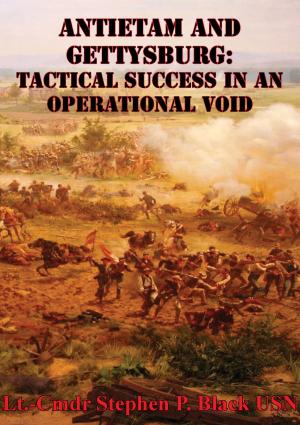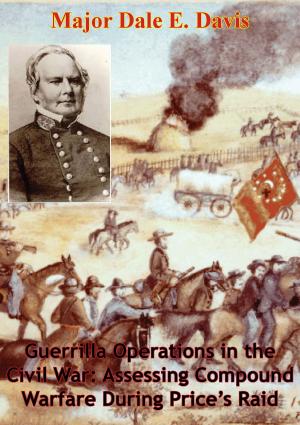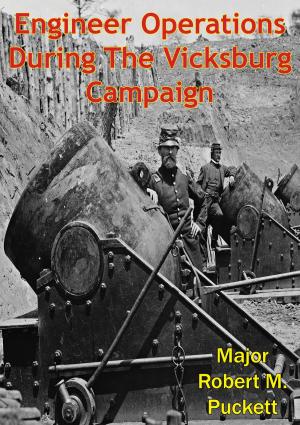Wilson’s Creek Staff Ride And Battlefield Tour [Illustrated Edition]
Nonfiction, History, Modern, 19th Century, Americas, United States, Civil War Period (1850-1877), Military| Author: | Major George E. Knapp | ISBN: | 9781782895268 |
| Publisher: | Golden Springs Publishing | Publication: | August 15, 2014 |
| Imprint: | Golden Springs Publishing | Language: | English |
| Author: | Major George E. Knapp |
| ISBN: | 9781782895268 |
| Publisher: | Golden Springs Publishing |
| Publication: | August 15, 2014 |
| Imprint: | Golden Springs Publishing |
| Language: | English |
Includes more than 14 maps and Illustrations
Armies of the North and South fought the Battle of Wilson’s Creek about ten miles southwest of Springfield, Missouri, on Saturday, 10 Aug. 1861...While the action at Wilson’s Creek was small compared to that at Gettysburg or Chickamauga, it remains significant and useful to students of military history.
...The Union defeat in battle and the death of General Nathaniel Lyon, so closely following the disaster at First Bull Run, caused the North to adopt a more serious attitude about the war and to realize that victory would come only with detailed planning and proper resourcing. Thus, the Union reinforced Missouri with soldiers and weapons during the fall and winter of 1861-62, while the Confederacy applied its scanty resources elsewhere. Although the exiled pro-Confederate state government voted to secede and sent delegates to Richmond, Virginia, Missouri effectively remained in the Union. Any questions about Missouri’s fate were settled at the Battle of Pea Ridge in March 1862, when Union forces turned back the last significant Confederate threat to Missouri.
Wilson’s Creek was a “first battle” for most of the soldiers who fought there. First battles often provide armies with special insights into the application of military art and science, and Wilson’s Creek was no exception. The Mexican War model of organization and combined arms battle was generally confirmed, but some key observations relating to technology and command and control emerged as well...In addition, artillery proved decisive at several key moments during the fighting. Cavalry, on its part, proved to be much less valuable, and this fact hinted at lessons to be learned later in the Civil War. Ultimately, the infantry of both sides played out the drama, and many of the most useful insights came from that branch.
Includes more than 14 maps and Illustrations
Armies of the North and South fought the Battle of Wilson’s Creek about ten miles southwest of Springfield, Missouri, on Saturday, 10 Aug. 1861...While the action at Wilson’s Creek was small compared to that at Gettysburg or Chickamauga, it remains significant and useful to students of military history.
...The Union defeat in battle and the death of General Nathaniel Lyon, so closely following the disaster at First Bull Run, caused the North to adopt a more serious attitude about the war and to realize that victory would come only with detailed planning and proper resourcing. Thus, the Union reinforced Missouri with soldiers and weapons during the fall and winter of 1861-62, while the Confederacy applied its scanty resources elsewhere. Although the exiled pro-Confederate state government voted to secede and sent delegates to Richmond, Virginia, Missouri effectively remained in the Union. Any questions about Missouri’s fate were settled at the Battle of Pea Ridge in March 1862, when Union forces turned back the last significant Confederate threat to Missouri.
Wilson’s Creek was a “first battle” for most of the soldiers who fought there. First battles often provide armies with special insights into the application of military art and science, and Wilson’s Creek was no exception. The Mexican War model of organization and combined arms battle was generally confirmed, but some key observations relating to technology and command and control emerged as well...In addition, artillery proved decisive at several key moments during the fighting. Cavalry, on its part, proved to be much less valuable, and this fact hinted at lessons to be learned later in the Civil War. Ultimately, the infantry of both sides played out the drama, and many of the most useful insights came from that branch.
![Cover of the book Wilson’s Creek Staff Ride And Battlefield Tour [Illustrated Edition] by Major George E. Knapp, Golden Springs Publishing](https://www.kuoky.com/images/2014/august/500x500/9781782895268-fQ42_500x.jpg)





![Cover of the book Battles And Victories Of Allen Allensworth, A.M., Ph.D., Lieutenant-Colonel, Retired, U.S. Army [Illustrated Edition] by Major George E. Knapp](https://www.kuoky.com/images/2014/june/300x300/9781782891222-UZeo_300x.jpg)

![Cover of the book When They Burned the White House [Illustrated Edition] by Major George E. Knapp](https://www.kuoky.com/images/2016/october/300x300/9781787201934-3qSv_300x.jpg)

![Cover of the book Staff Ride Handbook For The Vicksburg Campaign, December 1862-July 1863 [Illustrated Edition] by Major George E. Knapp](https://www.kuoky.com/images/2015/november/300x300/9781782899358-IHvn_300x.jpg)




